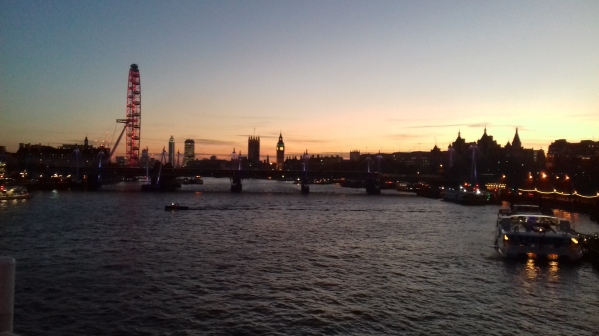
A shot of London from Waterloo Bridge, taken on my way home from the Hunterian Museum.
My last blog post was before Christmas so that’s nearly a month ago now. How time flies when you’ve got work to do! I would say my new years resolution would be to write more blog posts, but I’m not sure if I’ll have the time. As well my PhD work, the conference I’m a committee member for is getting ever closer! Maybe after March (and the conference) I’ll have some more time. I really want to expand these blog posts to more than ‘what I’ve been up to’ – maybe I’ll have the time soon!
Ah, Christmas feels so long ago now, but it was lovely. I managed to have a week off to see family, catch up with some old friends and generally chill out for a bit. It was great – even with a horrible cough and cold! But a week goes pretty fast when you’re having fun and I was soon home again and back carrying on with the PhD.
The PhD stuff is going well, I’ve booked to go and visit some new museums (that have Neolithic remains hooray!) and started going down to visit the Dorset County Museum. It’s pretty far to go but they have some really useful collections. Plus their stores are in a church, which is quite interesting if a little cold! I’ve said before that I really enjoy going to these museums as I get to meet new people. This week that included Claire Randall a zoo- and osteo- archeologist. We had a lovely chat and it was great finding out about her work. This week I’ve also been brushing up on my statistics, which I have a love-hate relationship with! It can be a pain to get through but it’s so satisfying once you’ve done it and got it right!
Enough about the PhD work. The other cool thing I’m involved in at the moment is the Skeletons Stories and Social Bodies conference. I’ve talked about in many times (and you can find out even more by visiting our website) but it’s now getting quite close! We’ve now had all of the abstracts in and produced a draft schedule. I am really looking forward to it as we have some great presentations covering a wide range of things! I know the speakers will be great but I also can’t wait to meet some of the delegates. There are quite a few people on social media who have been really supportive and enthusiastic about the conference and it would be great to finally put some names to faces! Not to long to wait now 😀
Finally, today I was back helping pack the collections at the Hunterian Museum. I think I asy this every time but I do enjoy working there. The people are great and I love the museum, but it also gives me some head space away from my PhD work. It’s so easy to become obsessed and constantly worried that I should be working that it’s nice to escape once a fortnight! So I’ll be back there in two weeks time, still packing away.




